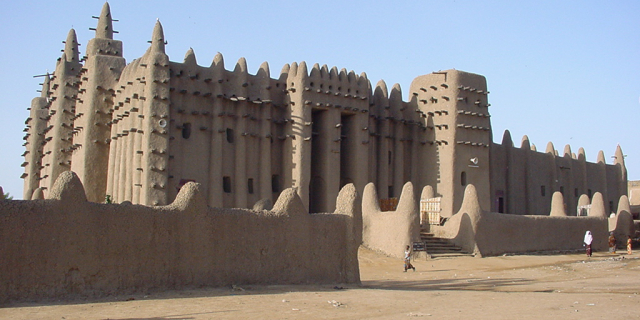Bandiagara Escarpment
The Bandiagara Escarpment (Arabic: منحدرات باندياغارا الصخرية, French: falaise de Bandiagara) is an escarpment in the Dogon country of Mali. The sandstone cliff rises about 500 m (1,600 ft) above the lower sandy flats to the south. It has a length of approximately 150 km (90 mi).
The area of the escarpment is inhabited today by the Dogon people. Before the Dogon, the escarpment was inhabited by the Tellem and Toloy peoples. Many structures remain from the Tellem. The Bandiagara Escarpment was listed in the UNESCO World Heritage List in 1989.
The Cliffs of Bandiagara are a sandstone chain ranging from south to northeast over 200 km (120 mi) and extending to the Grandamia massif. The end of the massif is marked by the Hombori Tondo, Mali's highest peak at 1,155 m (3,789 ft). Because of its archaeological, ethnological and geo...Read more
The Bandiagara Escarpment (Arabic: منحدرات باندياغارا الصخرية, French: falaise de Bandiagara) is an escarpment in the Dogon country of Mali. The sandstone cliff rises about 500 m (1,600 ft) above the lower sandy flats to the south. It has a length of approximately 150 km (90 mi).
The area of the escarpment is inhabited today by the Dogon people. Before the Dogon, the escarpment was inhabited by the Tellem and Toloy peoples. Many structures remain from the Tellem. The Bandiagara Escarpment was listed in the UNESCO World Heritage List in 1989.
The Cliffs of Bandiagara are a sandstone chain ranging from south to northeast over 200 km (120 mi) and extending to the Grandamia massif. The end of the massif is marked by the Hombori Tondo, Mali's highest peak at 1,155 m (3,789 ft). Because of its archaeological, ethnological and geological characteristics, the entire site is a point of interest.
The cave-dwelling Tellem, an ethnic group later pushed out by the arrival of the Dogons, used to live in the slopes of the cliff. The Tellem legacy is evident in the caves they carved into the cliffs so that they could bury their dead high up, far from the frequent flash floods of the area.
Dozens of villages are located along the cliff, such as Kani Bonzon. It was near this village that the Dogons arrived in the 14th century, and from there they spread over the plateau, the escarpment and the plains of the Seno-Gondo.
According to local oral history, the Dogon were relatively undisturbed by French colonial powers due to natural tunnels weaving through the Bandiagara Escarpment. Only the Dogon knew of the tunnels, and were able to use them to ambush and repel aggressors.





























Add new comment